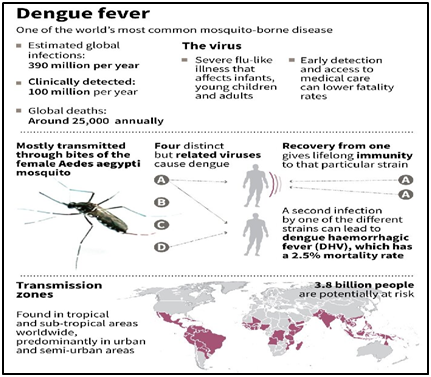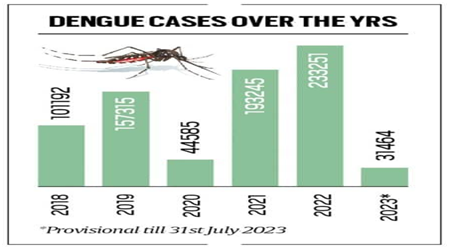Why in News?
- With the expanding geography of dengue infections in India as well as the world an increasing need has been felt for an effective vaccine that can protect against all four serotypes.
What’s in Today’s Article?
- Dengue Fever (About, spread, symptoms, treatment, protection, fighting dengue)
- Situation in India
- Development of Dengue Vaccines
- Fighting Dengue
Dengue Fever:

- About: It is a mosquito-borne tropical disease caused by the dengue virus, which belongs to the family Flaviviridae, having four serotypes that spread by the bite of infected Aedes mosquitoes.
- How is Dengue spread?
- Primary vectors: Infected female Aedes (especially Aedes aegypti) mosquitoes, which are found (in urban habitats) in tropical and subtropical regions around the world.
- These mosquitoes breed primarily in man-made containers such as buckets of water, potted plants, and other similar items.
- Role of weather: Unlike the malaria mosquito (Anopheles), which grows in stagnant water in open settings, the Aedes aegypti mosquito breeds in freshwater, bringing mosquitoes closer to humans.
- Water continuously accumulates and is washed away during heavy rainfall, sweeping any mosquito larvae away.
- Dry conditions, on the other hand, cause rainwater to remain stagnant, which is ideal for mosquito breeding and multiplication.
- Symptoms:
- 75% of dengue infections are asymptomatic (showing no symptoms), 20% of dengue infections are mild-to-moderate, while 5% of cases are severe dengue.
- Severe dengue can lead to dengue hemorrhagic fever, which causes bleeding, low blood platelet levels and blood plasma leakage, or dengue shock syndrome, which causes dangerously low blood pressure.
- Treatment: There is no specific treatment for dengue or severe dengue, but early detection and access to proper medical care lowers fatality rates to below 1%.
Situation in India:

- Nearly half the population of the world lives at risk of the disease at present.
- The disease in India has spread from just 8 states and UTs in 2001 to all states by 2022. Ladakh was the last bastion from where two infections were reported last year.
- As per the latest data, there have been 31,464 cases and 36 deaths due to dengue reported across the country till the end of July this year.
- The reason for the larger number of cases in these states is not just the weather, but also the lack of infrastructure for confirming dengue diagnosis.
- There are several efforts ongoing within the country to develop an effective vaccine against the mosquito-borne disease that can lead to internal bleeding, circulatory shock, and death.
Development of Dengue Vaccines:
- At present, there are some vaccine candidates that are being tested in humans in India. For example,
- A vaccine developed by Panacea Biotec based on live weakened versions of the four dengue serotypes developed by the National Institute of Allergy and Infectious Diseases in the US.
- A second vaccine candidate was developed by the Serum Institute of India with the same weakened virus from the US.
- There are at least two indigenous vaccines against dengue under development in research institutes.
- One of the main challenges of developing a dengue vaccine is antibody-dependent enhancement (ADE).
- A person with low levels of antibodies against one serotype of dengue, may end up getting a more severe infection with another serotype of dengue.
- To do away with this problem, both the Indian research teams selected a specific part of the envelope protein known to not cause ADE.
- For example, the team from the International Centre for Genetic Engineering and Biotechnology (ICGEB) created a Virus-Like Particle using these parts of the virus.
- The vaccines were shown to offer almost 100% protection against all four serotypes.
Fighting Dengue:
- At the global level: The WHO’s strategy for dengue prevention and control aims to reduce mortality by 50% and reduce morbidity by 25% by 2020.
- It focuses on 5 elements - Diagnosis and case management; Integrated surveillance and outbreak preparedness; Sustainable vector control; Future vaccine implementation; Research.
- To achieve these goals, a globally coordinated and integrated approach to addressing dengue fever is required.
- Steps taken by Indian government:
- Creating awareness: National Dengue Day is observed in India on May 16 with the recommendation of the Ministry of Health and Family Welfare (MoHFW), to create awareness about dengue.
- Prevention and control: National Vector Borne Disease Control Programme is the nodal centre for the surveillance and prevention of dengue in India.
- Integrated disease surveillance programme: It also helps in disease surveillance and outbreak detection or investigation of dengue in the country.
- Notification of dengue cases: MoHFW has made notification of dengue cases essential.
- Genome sequencing:
- In a first, Pune’s B J Government Medical College to undertake genome sequencing of dengue virus.
- Genome sequencing will involve analysing the genetic makeup of the virus and aims to create a comprehensive understanding of dengue.









